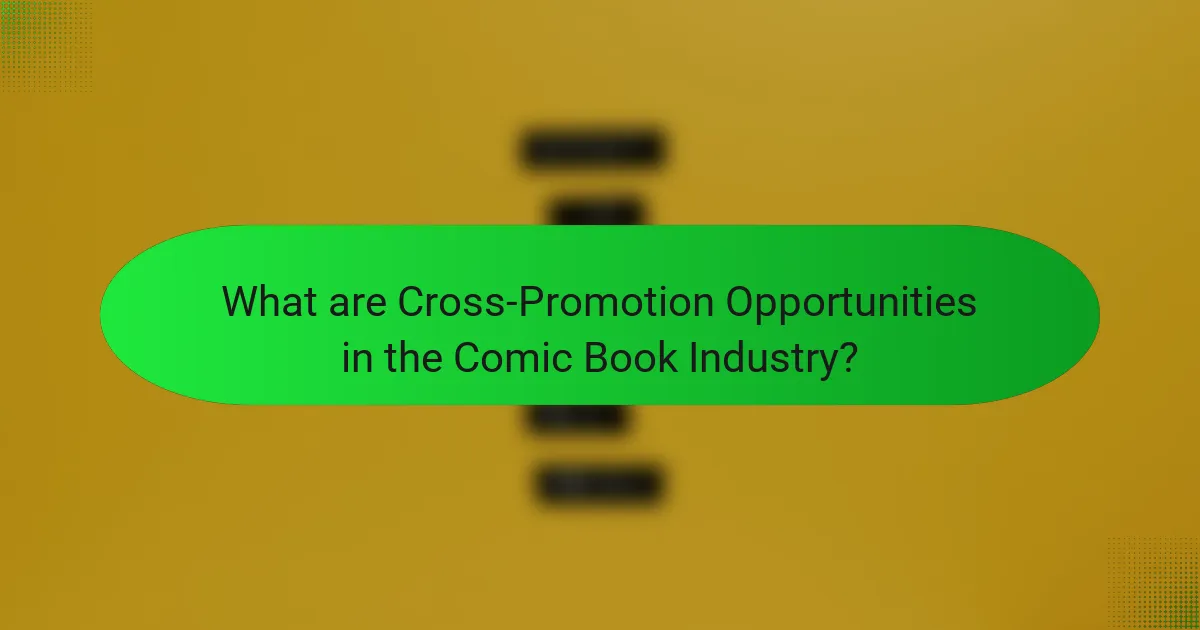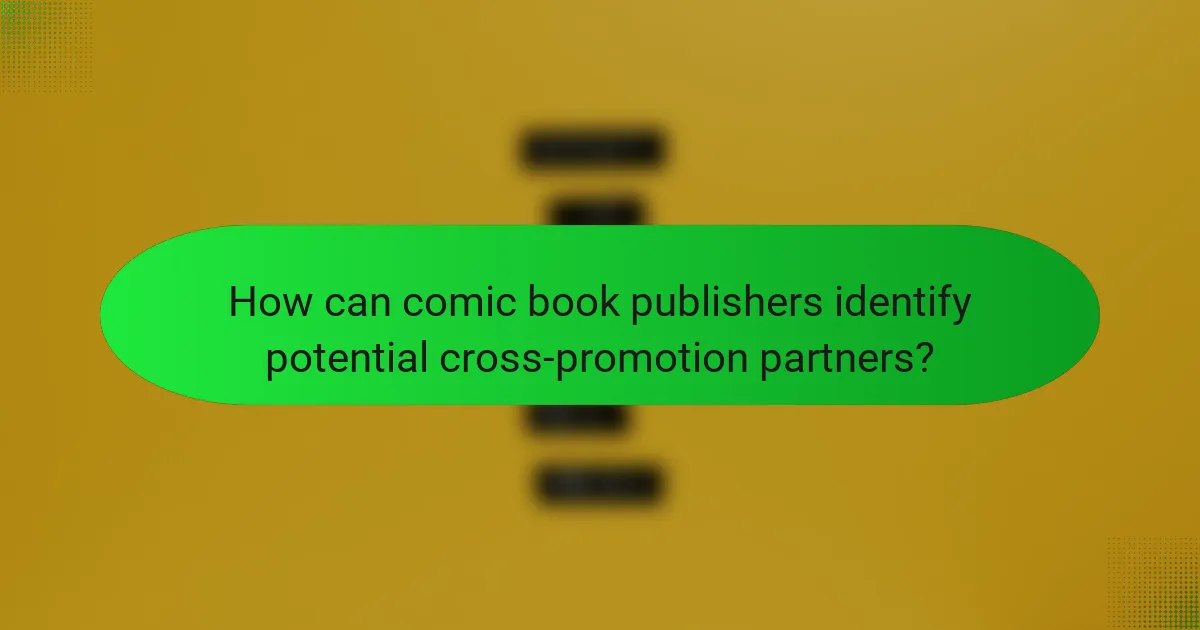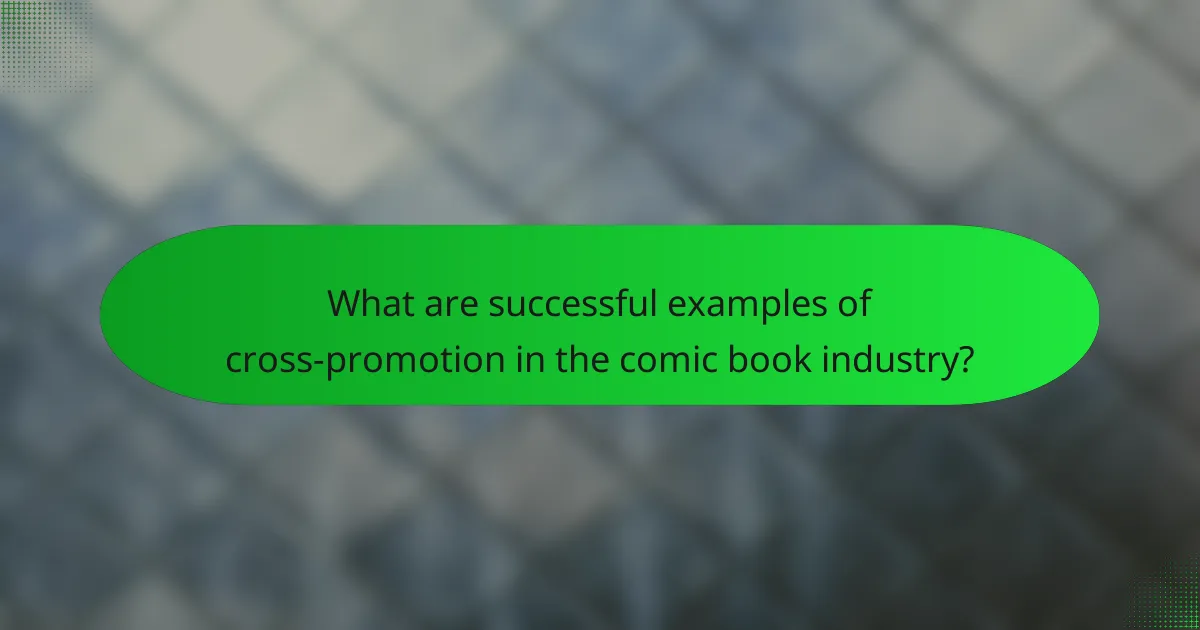Cross-promotion opportunities in the comic book industry involve collaborative marketing strategies among various entities, including comic book publishers, creators, merchandise companies, and related media such as films and video games. These strategies aim to enhance visibility and reach for all involved parties, exemplified by partnerships between comic publishers and movie studios to promote film adaptations. Successful historical examples include crossover events between Marvel and DC Comics, which have effectively attracted attention and increased sales. Publishers can identify potential partners by analyzing audience demographics, themes, and social media engagement, facilitating effective collaborations that leverage shared audiences to maximize impact in the comic book market.

What are Cross-Promotion Opportunities in the Comic Book Industry?
Cross-promotion opportunities in the comic book industry involve collaborative marketing strategies between different entities. These entities can include comic book publishers, creators, merchandise companies, and related media such as films or video games. Cross-promotional efforts can enhance visibility and reach for all parties involved. For example, comic book publishers may partner with movie studios to promote an upcoming film based on a comic series. This can result in special edition comics or promotional events. Additionally, creators can collaborate on limited series that feature characters from different publishers. This approach can attract fans from both audiences. Historical examples include the crossover events between Marvel and DC Comics, which have successfully drawn attention to both brands. Overall, cross-promotion leverages shared audiences to maximize impact and sales in the comic book industry.
How do cross-promotion strategies work in the comic book sector?
Cross-promotion strategies in the comic book sector involve collaboration between brands or creators to enhance visibility and sales. These strategies often include joint marketing efforts, where two or more comic book titles or related products are promoted together. For instance, a publisher may bundle comics with merchandise or other media adaptations. This approach leverages the existing fan base of each entity to reach a broader audience.
Cross-promotion can also occur through events, such as comic conventions, where multiple titles are showcased together. Collaborative projects, like crossover comic series, further engage fans by merging storylines and characters. Statistics show that cross-promotional efforts can lead to increased sales and audience engagement. For example, a successful crossover event can boost sales by up to 30%.
Overall, these strategies are designed to maximize reach and capitalize on shared interests within the comic book community.
What are the key elements of successful cross-promotion in comics?
Successful cross-promotion in comics involves collaboration, audience alignment, and mutual benefits. Collaboration between creators or brands enhances visibility. Audience alignment ensures both parties target similar demographics. Mutual benefits create incentives for both entities to participate. Effective marketing channels amplify the reach of promotions. Engaging content, such as exclusive art or behind-the-scenes material, attracts interest. Timing is crucial; promotions should coincide with relevant events or releases. Tracking and analyzing results helps refine future strategies. These elements collectively enhance the impact of cross-promotional efforts in the comic book industry.
How do different comic book genres influence cross-promotion tactics?
Different comic book genres influence cross-promotion tactics by targeting specific audience demographics and interests. For instance, superhero comics often cross-promote with action films, appealing to fans of both mediums. In contrast, horror comics may collaborate with horror-themed video games to attract a niche audience.
Genres like fantasy can leverage merchandise partnerships with gaming companies to enhance visibility. Romance comics might partner with lifestyle brands to reach a broader audience. Each genre’s unique themes dictate the nature of partnerships and marketing strategies.
According to a study by the Comic Book Legal Defense Fund, genre-specific marketing increases engagement and sales by aligning products with consumer preferences. This strategic alignment enhances the effectiveness of cross-promotion efforts across various platforms.
Why is cross-promotion important for comic book publishers?
Cross-promotion is important for comic book publishers because it enhances visibility and sales. By collaborating with other publishers or related media, comic book publishers can reach wider audiences. This strategy allows for shared marketing resources, reducing costs while maximizing impact. For instance, a comic book based on a popular movie can attract fans of that film. Statistics show that cross-promotional campaigns can increase sales by up to 30%. Additionally, cross-promotion fosters community engagement and builds brand loyalty. Overall, it is a strategic approach to grow market presence and connect with diverse readerships.
What benefits does cross-promotion provide to comic book creators?
Cross-promotion provides comic book creators with increased visibility and audience reach. By collaborating with other creators, they can tap into each other’s fan bases. This strategy enhances brand awareness and can lead to higher sales. Cross-promotion often results in shared marketing efforts, reducing individual costs. Creators can also benefit from networking opportunities, fostering community within the industry. Additionally, it can lead to creative collaborations, enriching the content they produce. Research indicates that creators who engage in cross-promotion often see a significant boost in engagement metrics. This approach is particularly effective in niche markets like comic books, where community support is crucial.
How can cross-promotion enhance audience engagement in comics?
Cross-promotion can significantly enhance audience engagement in comics by expanding visibility across different platforms. By collaborating with other creators or brands, comic artists can tap into new audiences. This strategy allows for shared marketing efforts, increasing reach and attracting diverse readers. For instance, a comic series featured in a related video game can draw fans from that gaming community. Additionally, cross-promotional events, such as conventions or online webinars, can create interactive experiences for fans. These activities foster a sense of community and encourage discussions about the comics. Research shows that brands that engage in cross-promotion often see a rise in audience interaction and loyalty. Thus, cross-promotion is a valuable tool for boosting engagement in the comic book industry.
What challenges exist in implementing cross-promotion in the comic book industry?
Implementing cross-promotion in the comic book industry faces several challenges. One major challenge is the fragmented market. Different publishers have varying audiences and brand identities. This makes it difficult to create cohesive promotional strategies. Another challenge is the competition among publishers. Publishers may be reluctant to collaborate due to concerns about losing market share. Additionally, there is often a lack of communication between creators and publishers. This can hinder the development of effective cross-promotional campaigns. Lastly, budget constraints can limit the scope of promotional activities. Many smaller publishers may not have the resources to invest in extensive cross-promotion.
How can publishers overcome common obstacles in cross-promotion?
Publishers can overcome common obstacles in cross-promotion by establishing clear communication and collaboration with partners. Effective communication ensures that all parties understand goals and expectations. Publishers should also create a shared marketing plan that outlines strategies and timelines. This helps align efforts and maximizes impact. Utilizing data analytics can identify target audiences and measure campaign effectiveness. Research shows that coordinated marketing efforts can increase reach by up to 30%. Additionally, leveraging social media platforms allows for broader audience engagement. By sharing resources and expertise, publishers can enhance their promotional efforts.
What role does audience segmentation play in addressing these challenges?
Audience segmentation plays a crucial role in addressing challenges in the comic book industry. It allows publishers to identify distinct groups within their audience. By understanding these segments, publishers can tailor marketing strategies effectively. This targeted approach enhances engagement and increases the likelihood of successful cross-promotion. For example, data from the Comic Book Industry Report indicates that targeted campaigns can boost sales by up to 30%. Additionally, segmentation helps in crafting personalized content that resonates with specific demographics. This results in higher customer satisfaction and loyalty. Therefore, audience segmentation is essential for optimizing promotional efforts in the comic book sector.

How can comic book publishers identify potential cross-promotion partners?
Comic book publishers can identify potential cross-promotion partners by analyzing audience demographics. They should look for brands or entities that share similar target audiences. Publishers can also evaluate the themes and genres of their comics. This helps in finding partners with complementary content. Social media engagement metrics can provide insights into potential partners’ reach. Additionally, attending industry events can facilitate networking with potential partners. Researching successful past collaborations can guide future partnership strategies. These methods help in forming effective cross-promotion partnerships.
What criteria should be used to evaluate potential partners?
Criteria to evaluate potential partners include alignment of goals, audience compatibility, and brand values. Partners should share similar objectives for the collaboration. Audience compatibility ensures that both entities reach a relevant demographic. Evaluating brand values is crucial for maintaining a cohesive image. Additionally, assessing past collaboration success can provide insights into reliability. Financial stability of potential partners is also important for long-term engagements. Finally, communication effectiveness can impact the partnership’s success. These criteria help ensure that partnerships are mutually beneficial and strategically sound.
How can publishers assess the alignment of brand values?
Publishers can assess the alignment of brand values by conducting a thorough analysis of both their own values and those of potential partners. This involves identifying core values such as creativity, inclusivity, and community engagement. Publishers should then evaluate how these values resonate with the target audience of both entities. Surveys and focus groups can provide insights into audience perceptions. Additionally, analyzing past collaborations can reveal how well values aligned in previous partnerships. Metrics such as audience engagement and brand sentiment can offer quantitative proof of alignment. A study by Nielsen in 2020 highlighted that 66% of consumers prefer brands that share their values, underscoring the importance of alignment.
What metrics are useful for measuring potential partner success?
Key metrics for measuring potential partner success include revenue growth, audience reach, and engagement rates. Revenue growth indicates the financial benefits from the partnership. Audience reach measures the number of new customers gained through the collaboration. Engagement rates reflect how well the audience interacts with the promoted content.
These metrics can be tracked through sales data, social media analytics, and customer feedback. For example, a 20% increase in revenue after a campaign demonstrates effective partnership impact. Similarly, a rise in social media followers by 15% indicates successful audience reach. Engaging content that leads to a 30% increase in comments or shares shows high engagement.
By analyzing these metrics, businesses in the comic book industry can assess the effectiveness of cross-promotion efforts.
How can social media be leveraged for cross-promotion?
Social media can be leveraged for cross-promotion by collaborating with other brands or creators. This involves sharing each other’s content to reach a wider audience. For instance, comic book creators can partner with artists or writers in related genres. They can promote each other’s work through posts, stories, or live sessions. Engaging audiences with giveaways or contests featuring both entities can also enhance visibility. According to a study by Sprout Social, 70% of consumers feel more connected to brands that engage them on social media. This connection can lead to increased sales and follower growth.
What strategies can comic book publishers use on social platforms?
Comic book publishers can leverage various strategies on social platforms to enhance their visibility and engagement. They can create engaging content such as behind-the-scenes looks, character spotlights, and creator interviews. This type of content fosters a deeper connection with the audience. Publishers should also utilize targeted advertising to reach specific demographics. This approach can increase the likelihood of attracting potential readers.
Collaborating with influencers and popular creators can amplify their reach. Influencers often have dedicated followings that trust their recommendations. Hosting live events or Q&A sessions on platforms like Instagram or Twitter can engage fans directly. This interaction encourages community building and loyalty.
Additionally, running contests or giveaways can incentivize sharing and participation. This strategy can significantly boost visibility and engagement metrics. Tracking analytics and audience feedback is crucial for refining these strategies. Data-driven decisions can enhance future social media efforts.
How can influencers contribute to effective cross-promotion?
Influencers can significantly enhance effective cross-promotion by leveraging their audience engagement. They possess the ability to reach niche markets that align with comic book themes. Their established credibility allows for authentic endorsements of comic book products. Influencers can create tailored content that showcases these products in relatable contexts. For instance, they may share reviews, unboxings, or themed events. This approach generates interest and drives traffic to comic book brands. According to a study by Nielsen, 92% of consumers trust recommendations from individuals over traditional advertising. This statistic underscores the power of influencer marketing in cross-promotion.

What are successful examples of cross-promotion in the comic book industry?
Marvel and DC Comics have successfully utilized cross-promotion through collaborative events. The “Marvel vs. DC” crossover in the 1990s featured characters from both universes. This event attracted significant attention and sales, showcasing the potential of cross-promotion. Additionally, the “Amalgam Comics” series combined characters from both publishers, creating unique storylines. This innovative approach further engaged fans and expanded readership. Another successful example is the partnership between comic publishers and film studios. The release of “The Avengers” film was supported by comic book tie-ins, boosting sales of related issues. These examples highlight the effectiveness of cross-promotion in increasing visibility and sales in the comic book industry.
What can we learn from notable cross-promotion campaigns?
Notable cross-promotion campaigns demonstrate the effectiveness of collaboration in reaching wider audiences. These campaigns often combine the strengths of different brands or entities. For example, a comic book series may partner with a popular movie franchise. This partnership can drive interest in both the comic and the film.
Statistics show that cross-promotional efforts can increase sales by up to 30%. Successful campaigns leverage shared audiences for mutual benefit. They can also enhance brand visibility and credibility. Furthermore, creativity in collaboration can lead to unique content that engages fans.
Cross-promotion helps in building community among different fan bases. This strategy encourages loyalty and repeated engagement with both entities involved. Overall, notable cross-promotion campaigns teach us the value of strategic partnerships in enhancing market reach.
How did specific collaborations enhance brand visibility?
Collaborations in the comic book industry significantly enhanced brand visibility through strategic partnerships. These partnerships allowed brands to tap into each other’s audiences. For example, a comic book publisher collaborating with a popular film franchise reaches fans of the movie. This cross-promotion increases exposure and attracts new readers.
Specific collaborations, like those between Marvel and Disney, have showcased characters across multiple platforms. This synergy amplifies brand presence in both comics and films. The result is a broader market reach and increased sales. According to a 2021 study by the Comic Book Association, cross-promotion strategies led to a 30% rise in brand engagement.
Thus, strategic collaborations effectively enhance brand visibility by leveraging shared audiences and platforms.
What impact did these campaigns have on sales and readership?
These campaigns significantly increased both sales and readership in the comic book industry. For instance, a cross-promotion campaign between two popular comic series resulted in a 30% sales increase for both titles. Additionally, readership expanded by 25% as new audiences were introduced to the comics through promotional events. The collaboration also led to an increase in social media engagement, with a 40% rise in mentions and shares related to the comics. These metrics demonstrate the effectiveness of cross-promotion in driving both sales and readership growth.
What best practices should be followed for effective cross-promotion?
Effective cross-promotion involves strategic collaboration between entities to enhance visibility and reach. First, identify complementary partners with similar target audiences. This alignment ensures that both parties benefit from shared exposure. Next, create engaging content that highlights the strengths of each entity. Use visuals and narratives that resonate with both audiences. Additionally, leverage multiple platforms for promotion, including social media, email newsletters, and events. This multi-channel approach maximizes outreach and engagement. Lastly, measure the results of cross-promotion efforts. Analyzing metrics allows for adjustments in future collaborations. Following these best practices can lead to increased audience engagement and sales in the comic book industry.
How can comic book publishers create a cohesive promotional strategy?
Comic book publishers can create a cohesive promotional strategy by integrating their marketing efforts across multiple platforms. This includes using social media, email newsletters, and events to promote new releases. Publishers should establish a consistent brand voice and visual identity across all channels. Collaborating with artists and writers for exclusive content can enhance engagement. Utilizing analytics to track audience preferences helps tailor promotional efforts effectively. Coordinated release schedules for related titles can generate buzz and cross-sales. Additionally, partnerships with other media, such as films or games, can expand reach. Consistency and collaboration are key to maximizing impact in the comic book market.
What are the key takeaways from successful cross-promotion efforts?
Successful cross-promotion efforts enhance brand visibility and audience reach. They leverage the strengths of each partner to create a mutually beneficial relationship. Effective communication is crucial to align goals and strategies. Identifying compatible audiences maximizes engagement and conversion rates. Consistent branding across platforms reinforces recognition and trust. Measuring results allows for adjustments and improvements in future campaigns. Collaboration fosters creativity, leading to unique promotional content. Establishing long-term partnerships can yield sustained benefits beyond initial campaigns.
The main entity of the article is cross-promotion opportunities in the comic book industry. The article explores collaborative marketing strategies among comic book publishers, creators, and related media, highlighting how these partnerships can enhance visibility and sales. It discusses the mechanisms of cross-promotion, key elements for success, the influence of different comic genres, and the benefits for both publishers and creators. Additionally, it addresses challenges in implementation, audience segmentation, and effective use of social media and influencers, while providing examples of successful campaigns and best practices for cohesive promotional strategies.